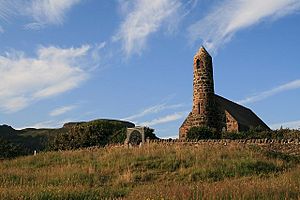St Columba's Church, Canna facts for kids
Quick facts for kids Church of Scotland Canna |
|
|---|---|
| Canna Rhu Church, Canna Church | |

Church in 2008 with the 1969 gate at left.
|
|
| 57°03′31″N 6°29′37″W / 57.0587°N 6.4935°W | |
| Denomination | Church of Scotland |
| History | |
| Status | Active |
| Dedication | St Columba |
| Architecture | |
| Heritage designation | Category B |
| Designated | 5 October 1971 |
| Architect(s) | P. M. Chalmers |
| Groundbreaking | 1912 |
| Completed | 1914 |
| Specifications | |
| Number of spires | 1 |
| Materials | stone |
| Bells | 1 |
| Administration | |
| Parish | North West Lochaber |
St Columba's Church is a special old building on the island of Canna in Scotland. It is part of the Small Isles in the Highland region. This church is officially recognized as a "Category B listed building," which means it is important for its history and design.
Contents
History of the Church
Why the Church Was Built
Before this church was built, people on Canna who were Protestant had to travel about 30 miles. That was a very long way to find a church! A lady named Mary Johanna Cameron started the idea for the church. Her husband, Allan Thom, came from the family who owned Canna until 1938.
The church was built to remember Allan's father, Robert Thom. Robert bought Canna in 1881 and helped make the island better. Even though the church was for Protestants, most people on Canna were, and still are, Catholic.
Church Design and Features
The church faces a bit differently than most churches. It points East-North-East to West-South-West, instead of the usual East-West. No one is quite sure why! The church has a graveyard, but it only has one headstone. This headstone belongs to Joanna and Allan Thom.
In 1969, a fancy metal gate was added to the churchyard. The church became a listed building in 1971. Because of the unique shape of its tower, many people informally call it 'The Rocket Church'.
The Ancient Cross Nearby
To the west of the church, there is an amazing old stone cross. It is called the sculptured cross. This ancient Celtic Christian cross was made a very long time ago, between the 8th and 9th centuries.
The Church Today
Current Use of St Columba's
Today, Canna has a small population of about 20 people. Most islanders are Catholic. Because of this, St Columba's Church is not used very often for services. However, it is still a consecrated building, meaning it is still considered a holy place for worship.
In 2015, the National Trust for Scotland, which looks after many important places, was trying to raise money. They wanted to fix up the church. Their plan was to use it as a place to show old items from when the Thom family owned Canna (1881-1938). Close by, there is also the island's Catholic chapel, which is also named after St Columba.
Images for kids




